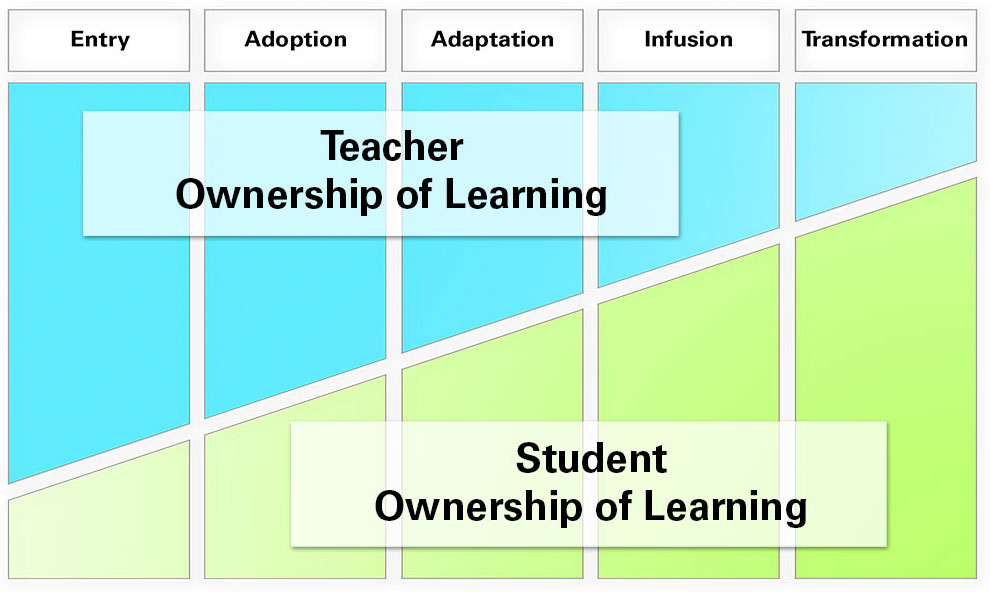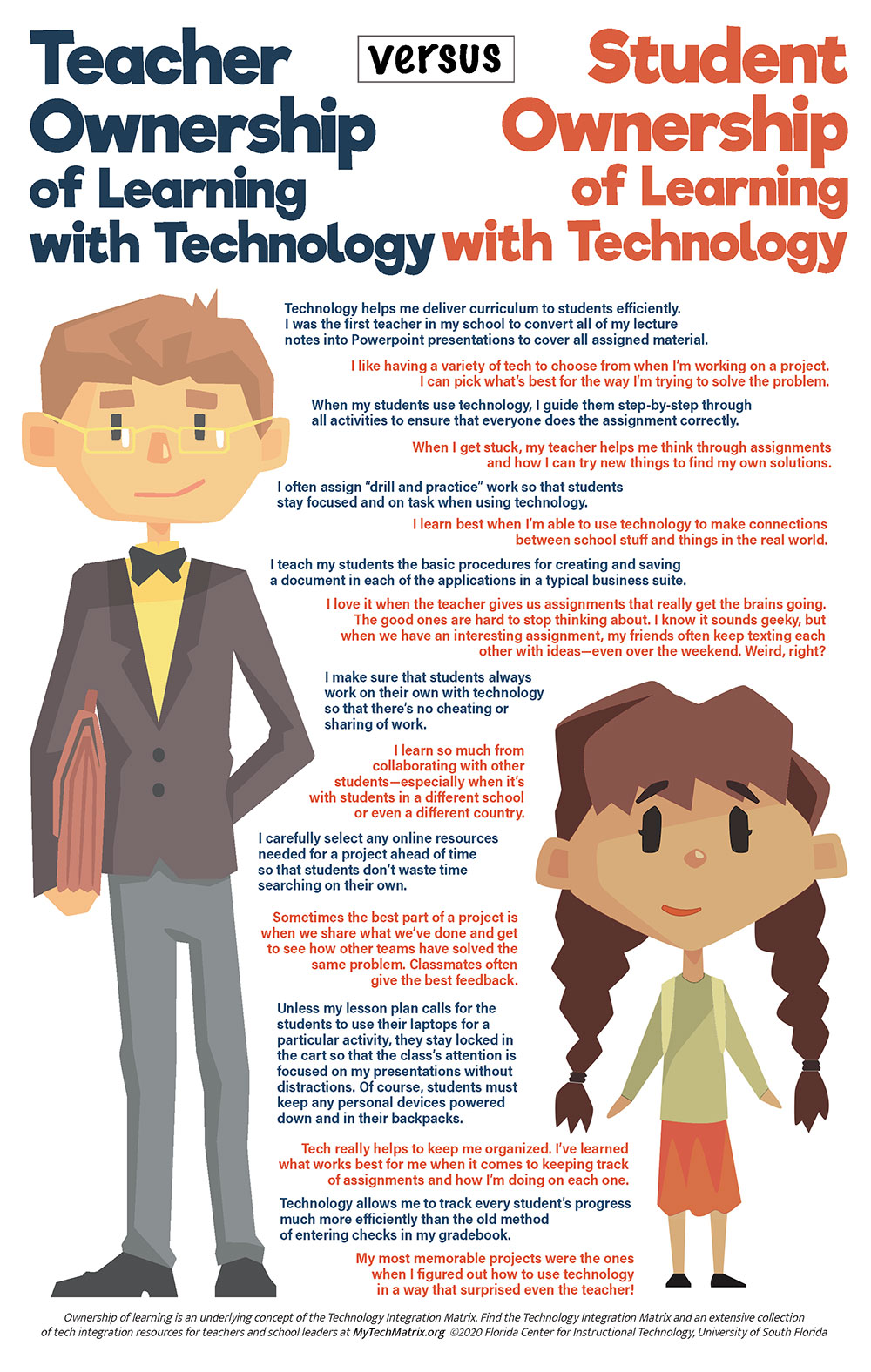Last year I wrote a post called “The Invisible Technology Integration Matrix” in which I introduced the reader to some of the underlying concepts of the Technology Integration Matrix or TIM for short. One of the most important concepts behind the TIM is the ownership of learning. At lower levels of technology integration, the teacher is the one directing how students are to use technology in class. Sometimes it’s even that the teacher is the ONLY one using technology in the classroom. Of course, there’s nothing “wrong” with Entry or Adoption levels of technology integration if, in fact, students are just being introduced to technology. However, as educators, our goal should always be for the students to take progressively greater ownership of their learning. We’re trying to create lifelong learners, not people who stop learning the day they graduate because learning was always something done to them rather than something they took responsibility for themselves.

Moving toward a classroom that exemplifies student ownership of learning with technology is in no wise an abdication of a teacher’s responsibility or a diminishing of teacher effort and preparation. And it certainly doesn’t happen overnight! In fact, it’s much easier in the short term just to dictate step-by-step what students are to do with technology. Increasing student ownership of technology learning initially requires much more work on the part of the teacher. But the benefits to the student are definitely worth it, even if the teacher has to repeat the process for every incoming class each year.
I’m sure that I’ve mentioned this elsewhere, but in my past work at FCIT I observed hundreds and hundreds of classrooms in many different public, private, and charter schools around the state of Florida. I would try as much as possible to be invisible in the back of the classroom so as not to disrupt the usual classroom procedures. From time to time, however, the teacher I was to observe would meet me at the doorway for a five, ten, or fifteen minute conversation as the students arrived and got right to work without any teacher direction or apparent oversight. I’d know that far from the teacher slacking, she had done an outstanding job moving her students toward ownership of their own learning. The students were engaged, productive, and taking responsibility—exactly what we hope for when they move on from school to the “real” world.
I created the following poster to capture some of the day-to-day thinking that begins to distinguish between teacher and student ownership of learning with technology. If you are a teacher, consider how you can move your students toward taking a greater ownership and responsibility for using technology in their learning. The Technology Integration Matrix is a great place to start your journey.

Download this poster as a PDF formatted for tabloid sized paper (11 by 17″).
Accessible Text
Title: Teacher Ownership of Learning with Technology versus Student Ownership of Learning with Technology
The poster includes an illustration of a teacher on the left with the following statements typical of teacher ownership of learning.
Technology helps me deliver curriculum to students efficiently. I was the first teacher in my school to convert all of my lecture notes into Powerpoint presentations to cover all assigned material.
When my students use technology, I guide them step-by-step through all activities to ensure that everyone does the assignment correctly.
I often assign “drill and practice” work so that students stay focused and on task when using technology.
I teach my students the basic procedures for creating and saving a document in each of the applications in a typical business suite.
I make sure that students always work on their own with technology so that there’s no cheating or sharing of work.
I carefully select any online resources needed for a project ahead of time so that students don’t waste time searching on their own.
Unless my lesson plan calls for the students to use their laptops for a particular activity, they stay locked in the cart so that the class’s attention is focused on my presentations without distractions. Of course, students must keep any personal devices powered down and in their backpacks.
Technology allows me to track every student’s progress much more efficiently than the old method of entering checks in my gradebook.
On the right of the poster is an illustration of a student with the following statements typical of student ownership of learning.
I like having a variety of tech to choose from when I’m working on a project. I can pick what’s best for the way I’m trying to solve the problem.
When I get stuck, my teacher helps me think through assignments and how I can try new things to find my own solutions.
I learn best when I’m able to use technology to make connections between school stuff and things in the real world.
I love it when the teacher gives us assignments that really get the brains going. The good ones are hard to stop thinking about. I know it sounds geeky, but when we have an interesting assignment, my friends often keep texting each other with ideas—even over the weekend. Weird, right?
I learn so much from collaborating with other students—especially when it’s with students in a different school or even a different country.
Sometimes the best part of a project is when we share what we’ve done and get to see how other teams have solved the same problem. Classmates often give the best feedback.
Tech really helps to keep me organized. I’ve learned what works best for me when it comes to keeping track of assignments and how I’m doing on each one.
My most memorable projects were the ones when I figured out how to use technology in a way that surprised even the teacher!
Poster footer: Ownership of learning is an underlying concept of the Technology Integration Matrix. Find the Technology Integration Matrix and an extensive collection of tech integration resources for teachers and school leaders at MyTechMatrix.org Copyright 2020 Florida Center for Instructional Technology, University of South Florida
Roy Winkelman is a 40+ year veteran teacher of students from every level kindergarten through graduate school. As the former Director of FCIT, he began the Center's focus on providing students with rich content collections from which to build their understanding. When not glued to his keyboard, Dr. Winkelman can usually be found puttering around his tomato garden in Pittsburgh.
